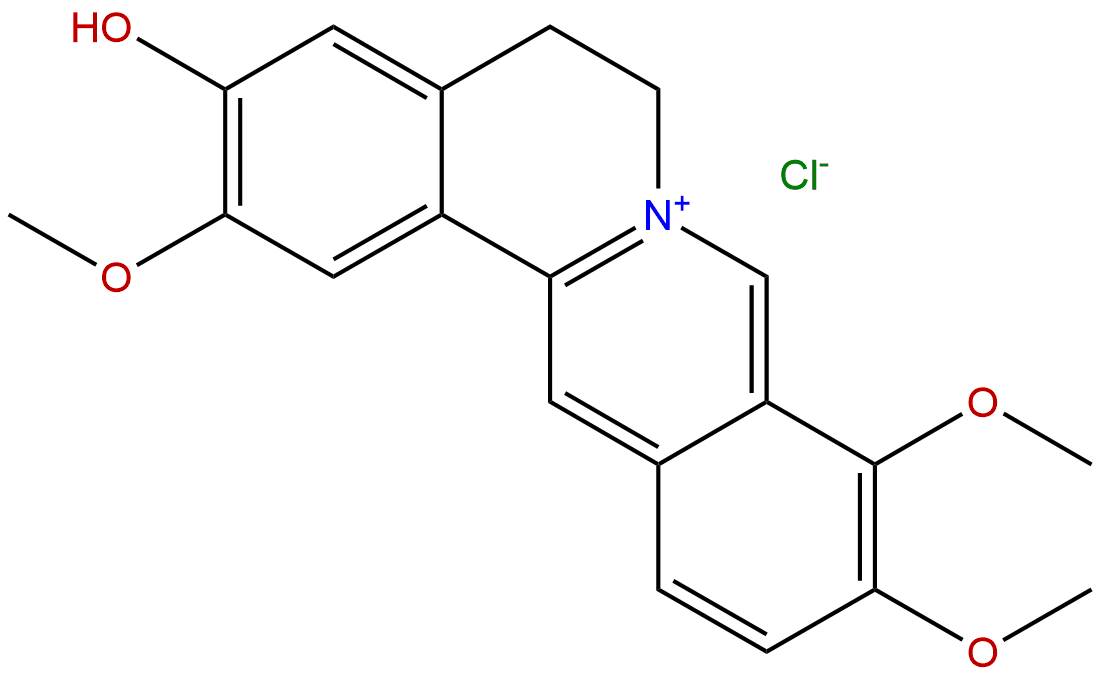
Jatrorrhizine chlorideCAS No.:6681-15-8
|
||||||||||
 |
|
|
||||||||

| Catalogue No.: | BP0809 |
| Formula: | C20H20ClNO4 |
| Mol Weight: | 373.833 |
Product name: Jatrorrhizine chloride
Synonym name: Neprotine chloride; Deleted Cas No.: 960383-96-4
Catalogue No.: BP0809
Cas No.: 6681-15-8
Formula: C20H20ClNO4
Mol Weight: 373.833
Botanical Source:
Purity: 95%~99%
Analysis Method: HPLC-DAD or/and HPLC-ELSD
Identification Method: Mass, NMR
Packing: Brown vial or HDPE plastic bottle
Can be supplied from milligrams to grams.
For Reference Standard and R&D, Not for Human Use Directly.
Inquire for bulk scale.
Description:
Jatrorrhizine hydrochloride has lipid lowering effects, it can ameliorate hyperlipidemia via the suppression of lipogenesis and the enhancement of lipid oxidation in the liver. It exhibits a potent inhibitory effect toward neuraminidase of the H7N9 (N9) avian influenza virus, it also can potentiate the neuraminidase inhibitory effect of oseltamivir towards H7N9 influenza. Jatrorrhizine hydrochloride is a potential new antimelanoma drug candidate, can inhibit the proliferation and neovascularization of C8161 metastatic melanoma cells with low toxicity.
References:
Anticancer Drugs. 2013 Aug;24(7):667-76.
Jatrorrhizine hydrochloride inhibits the proliferation and neovascularization of C8161 metastatic melanoma cells.
Malignant melanoma is the most aggressive form of skin cancer. Although various antimelanoma approaches have been used in the clinics to treat the disease over the last three decades, none of the drugs significantly prolonged the survival of metastatic melanoma patients; hence, effective drugs against metastatic melanoma are highly desired.
METHODS AND RESULTS:
In this study, we explored an antimetastatic melanoma agent derived from traditional Chinese medicinal herbs and found that Jatrorrhizine Hydrochloride (JH), an active component of the traditional Chinese medicinal herb Coptis chinensis, inhibited the proliferation and neovascularization of C8161 human metastatic melanoma cells. JH suppressed C8161 cell proliferation in a dose-dependent manner, with a half-maximal inhibitory concentration of 47.4±1.6 μmol/l; however, it did not induce significant cellular apoptosis at doses up to 320 μmol/l. Mechanistic studies showed that JH-induced C8161 cell cycle arrest at the G0/G1 transition, which was accompanied by overexpression of the cell cycle-suppressive genes p21 and p27 at higher doses. Moreover, JH reduced C8161 cell-mediated neovascularization in vitro and in vivo and impeded the expression of the gene for VE-cadherin, a key protein in tumor vasculogenic mimicry and angiogenesis.
CONCLUSIONS:
Taken together, the effective inhibitory effects of JH on metastatic melanoma cell proliferation and neovascularization with low toxicity suggest that JH is a potential new antimelanoma drug candidate.
Mol Med Rep. 2016 Oct;14(4):3277-84.
Jatrorrhizine hydrochloride attenuates hyperlipidemia in a high-fat diet-induced obesity mouse model. Jatrorrhizine Hydrochloride (JH) is an active component of the traditional Chinese herb Coptis chinensis, which has been used to prevent and treat metabolic disorders. Hyperlipidemia is one of the principal factors underlying numerous metabolic diseases, including diabetes and obesity. Therefore, the aim of the present study was to investigate the lipid lowering effects of JH treatment in vivo in an obesity mouse model. JH-treated hyperlipidemic mice exhibited a reduction in body weight, as well as improved glucose tolerance and insulin sensitivity. In addition, JH‑treated hyperlipidemic mice exhibited reduced serum triglyceride, total cholesterol and low‑density lipoprotein cholesterol levels, as well as increased high‑density lipoprotein cholesterol levels compared with untreated mice fed a high‑fat diet. Notably, JH treatment ameliorated the pathophysiological changes observed in the livers of hyperlipidemic mice. At the molecular level, JH downregulated the hepatic mRNA expression levels of SREBP‑1c and FAS, and induced PPAR‑α and CPT1A mRNA expression in hyperlipidemic mice. These findings suggest that JH ameliorates hyperlipidemia via the suppression of lipogenesis and the enhancement of lipid oxidation in the liver.
HPLC of Jatrorrhizine chloride
